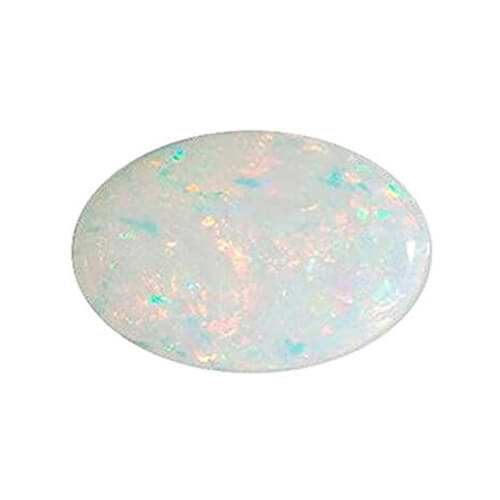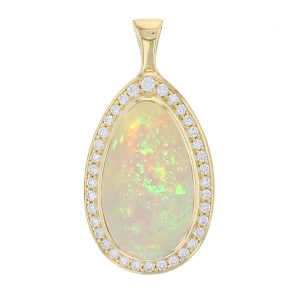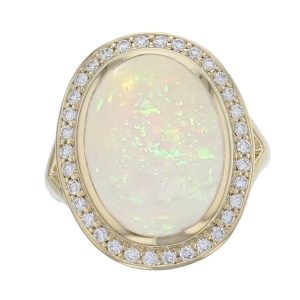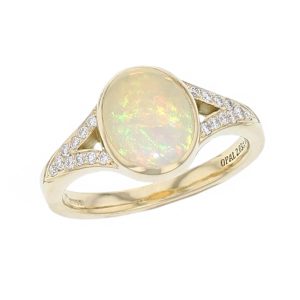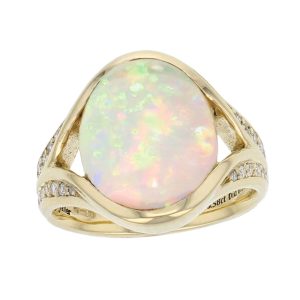-
ABOUT OPAL
Precious opal is one of the most unique and beautiful gems. Unlike most gemstones, Opal is amorphous which means it does not have a defined crystalline structure and occurs in many shapes and colours. The water content of opal can range from 3% to 21% but is normally between 6% and 10%.
The play of colour you see in opal is due to millions of tiny silica spheres in a close-packed lattice. These spheres refract light and cause the beautiful spectral colours you see in an opal. The regularity of the sizes and the packing of these spheres determines the quality of precious opal.
95% of the worldwide opal production has been mined in Australia over the last 100 years. Ethiopia has emerged as second major source of opal in the last 20 years. Other countries that mine opals include Brazil, Mexico, Indonesia, the Czech Republic and the USA.
-
AUSTRALIAN OPAL
Australian Opal is sedimentary in nature and is formed when rainwater seeps down into crevasses in the rock. As the water evaporates, the silica that is left behind dries out and over millions of years, this silica hardens into precious opal.
Australian Opals range from the most commonly white or ‘milky’ opals found in Coober Pedy in Queensland to the rare black opals of Lightning Ridge in New South Wales and boulder and matrix Opal in South Australia and Queensland. Boulder opal has a layer of solid brown ironstone left on the back of the stone while Matrix Opal consists of very thin seams or spots of precious opal intermixed with the dark ironstone or light sandstone host stone.
Generally, solid opals with a black or dark body tone are more valuable than those with a white, light, or crystal body tone because a stone with a darker body tone tends to display colours more vibrantly.
Australian opal formed in narrow fissures can produce very thin opals. Opals too thin to produce a “solid” as usually made into doublets or triplets. An opal doublet consists of a thin layer of precious opal, backed by a layer of dark material which emphasizes the play of colour, producing a similar effect to black or boulder opal at a fraction of the price. An opal triplet is similar to a doublet but has a third layer, a domed cap of clear quartz or plastic on the top. The cap takes a high polish and acts as a protective layer for the opal. The top layer also acts as a magnifier, to emphasize the play of colour of the opal beneath, which is often of lower quality. Triplet opals, therefore, have a more artificial appearance and are not classed as precious opal. At Faller, we only sell solid opal which means stones consisting wholly of precious opal.
-
ETHIOPIAN / WELO OPAL
Ethiopian opal was discovered in Welo, Ethiopia in 2008. It is currently one of most varied and spectacular opal types on the market. It is a high quality opal with great transparency and shows an amazing play of colour. The colours are evenly spread throughout the gem
Welo opal is more readily available in a wider variety of colours, in larger sizes and at lower prices than Australian opal. The price per carat of Welo opal is based on the intensity, variety and patterns of colour. Ethiopian opals once cut are highly stable. As the stones can be cut into thicker shapes they are more durable, resisting breakage better than all another opal including Australian opal.
Welo Opal is volcanic in origin which gives it different properties to Australian opal. The most notable is that Welo opal is hydrophane. This means that it has the ability to absorb water. If immersed in water for a long time the opal will become transparent and appear to loose its flashes of colour. Luckily this change isn’t perament and when Welo opal is left to dry naturally it will gradually revert to its original appearance.
-
FIRE OPAL
Fire Opal is a unique form of Opal found mainly in Mexico. Other sources are Brazil, Guatemala, Ethiopia and North,and South America. It is volcanic in origin and has a higher water content than other opals.
Fire Opal is a transparent to translucent opal, with warm body colours of pale yellow to deep red. It is sometimes known as jelly opal.
Cabochons are usually cut from material that shows a marked colour play. Material without the flashes of colour is normally faceted.
-
CARE
In general extra care needs to be taken as opals can be scratched relatively easily and any hard knocks can cause cracks. It is not recommended for rings that are worn daily but it is fine for use as pendants, earrings and brooches. Always remove any opal jewellery prior to playing sports, exercising, swimming or doing any household chores or gardening.
As opals have a relatively high water content, they are sensitive to temperature and extreme pressure changes. It is a safer to carry opal jewellery as hand luggage rather than hold luggage when flying. Never leave opal jewellery on a sunny window sill were drying out can cause hairline cracks.
Always avoid using any chemicals, toothpaste or abrasives when cleaning your opal jewellery. Clean with warm soapy water and a soft child’s toothbrush to remove build-up under the stone. Rinse well to remove any residue and dry with a soft lint-free cloth.
Care should be taken when wearing or storing any opal around other gems and jewellery. Ideally, store them in a sealed plastic bag with a damp cloth in case of drying out. To restore moisture in opal, rub a finger gently over the surface to contribute natural skin oil. Opals can also be rubbed with a bit of baby or mineral oil on a cotton swab.
When cleaning a doublet opal or triplet opal, do not immerse it in soapy water which may loosen the glue and separate the pieces. Instead, put a small amount of solution on the microfiber cloth and gently clean the opal with it.
If Ethiopian opals come into contact with water, they will absorb it like a sponge. This characteristic is known as hydrophane. If kept in water, the opal will gradually become glass clear. When removed, it will get milky and then after several days, the opal will return to its original beauty. How long this process takes depend on how long it was soaked and can wary from days to weeks. Washing your hands wearing an opal ring will have little effect but longer immersion should be avoided. Australian opal won’t react when soaked in water.
As Ethiopian opal is absorbent, chemicals including hair products, dyes, oils and lotions should also be avoided. Opal jewellery should be last thing on, first thing off.
